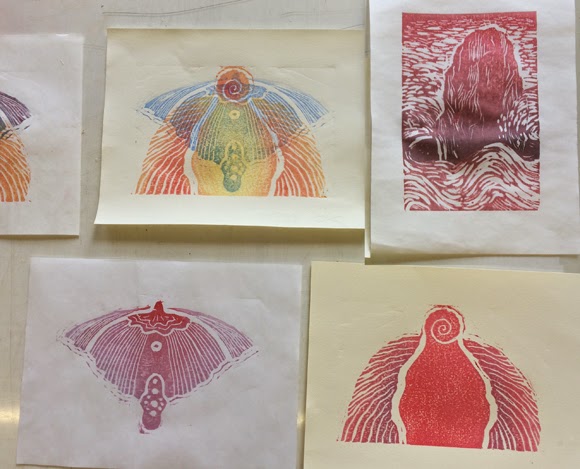
Here are my first prints using this process.
Moku hanga abstract series#
San Francisco-based Bay Area Rapid Transit (BART) selected Berkeley artist Miwako Nishizawa, born in Kyoto Japan, to create pieces for its 2016 poster art series using the moku hanga woodblock technique. McClains Printmaking Supplies is a good source for tools, blocks, and books about the process.Ĭarving can take a long time, but it’s an opportunity for contemplation, for “being in the moment” with your image, and the blocks eventually become works of art, along with the prints. As the images are all hand-pulled, moku hanga prints don’t need a press, and using water-based inks makes this for an easy clean-up.
Moku hanga abstract registration#
For multiple colors, multiple blocks are carved, with exact registration (kento) marks on each block. To make a print, the block’s surface is saturated with water color and nori paste, and then slightly dampened paper is laid down and pressed with a buren. The image, a type of relief print, is produced by carving away everything except the lines to be printed. In modern times the images may have changed, but the process remains much the same, and its simplicity is very appealing, requiring not much more than a block of wood, a cutting tool (gouge), ink, and paper. Brush Art Gallery.Moku hanga is a traditional Japanese form of woodblock printmaking notable for black outlines, vibrant colors, and angled perspectives (think of Hokusai and Hirosada). Carole Mathey is the assistant director of the Richard F.

Melissa Schulenberg is an associate professor of art and art history and teaches printmaking, drawing and artists’ books. Utagawa Kunisada (Toyokuni III), Japanese, 1786-1865,

The exhibition also includes a selection of traditional Japanese woodcuts, with accompanying curatorial text panels by students from Flint Professor Dorothy Limouze’s special topics seminar on museums and collections. There was no predetermined theme, and artists responded to the call with images of waterscapes, studies of color and light, and abstract forms from nature. Melissa also initiated an exchange portfolio, 20 Artists/20 Views, which includes work by international artists from the mokuhanga conference.


1830), the iconic ukiyo-e print by the Japanese artist Hokusai. The exhibition’s title, Riding the Great Wave, refers to The Great Wave Off Kanagawa, or simply The Great Wave (ca. In June of 2011, Melissa Schulenberg and Carole Mathey traveled to Kyoto, Japan, to attend the 1st International Mokuhanga Conference, where they met numerous artists, 12 of whom were invited to participate in an exhibition at St. Later ukiyo-e prints from the 1800s incorporated mokuhanga to depict vivid battle scenes, actors and courtesans in richly designed silk kimonos, transparent landscapes, and birds and animals from the zodiac. Dating back to the 8th century, mokuhanga techniques were first used to print Buddhist texts and images. Unlike western woodblock printing that employs oil-based inks, Japanese mokuhanga is a chemical- and solvent-free process that uses water-based inks, such as watercolors, gouaches and vegetable dyes. Lecture by Yoonmi Nam, associate professor of visual art, University of Kansas, Monday, March 25, at 7:00 p.m., in Griffiths 123 Ralph Kiggell, Yotsuya Schoolgirls, 1992, mokuhanga print, 17/40


 0 kommentar(er)
0 kommentar(er)
